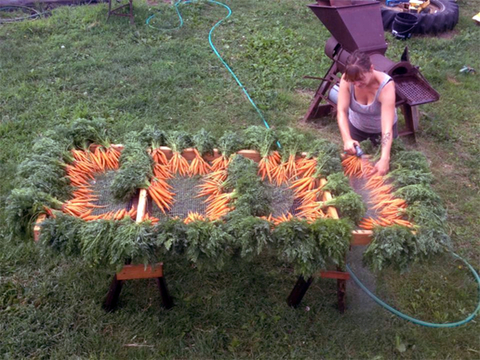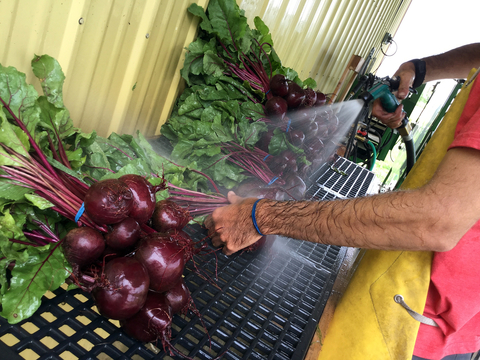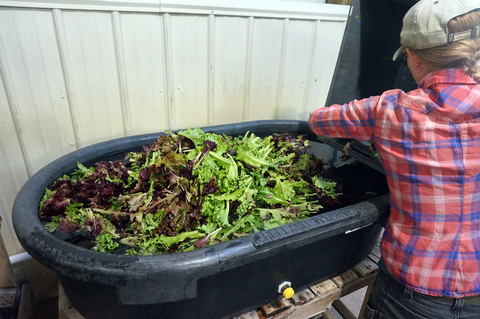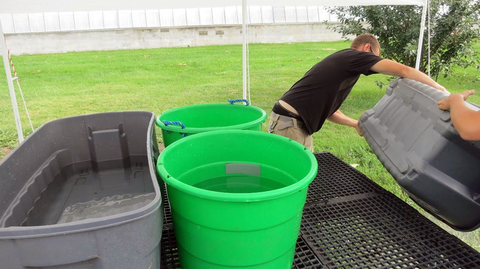Proper postharvest handling of fresh market fruits and vegetables will allow you to sell high-quality products and extend the shelf life of your produce.
Produce is at its highest quality at harvest, so culling diseased or injured produce (toss or sell them first) and storing only the highest quality product is recommended.
The tasks listed below will help you maintain the postharvest quality of your farm produce.
Removing field heat
The faster you get produce to the correct storage temperature, the longer it will last. You can help produce get to the appropriate storage temperature by removing the heat held by the product when it was growing in the field.
Harvest early in the morning, before the hottest part of the day, so that your produce starts out relatively cool. The following three methods can be used to remove field heat from fruits and vegetables.
Air cooling relies on cool air moving around the product. This is typically done in a walk-in cooler but can be as simple as putting harvested product in the shade. Most fruits and vegetables can be air-cooled.
For more information about building a walk-in cooler, see this guide from the University of Kentucky. If a grower has the capacity to build a cooler, this is typically the easiest option.
This method uses cool, clean water to bring the temperature of the produce down. This can be done either with a spray table or in a dunk tank.
Only produce items that can withstand water should be cooled. Only potable water should be used in postharvest washing.
The tanks and spray tables should be cleaned and sanitized regularly. Use a sanitizer in the water to reduce the potential for cross-contamination between crops.
For more information on sanitizers see the washing section below.
Some produce can be cooled with ice, but make sure the ice you use is made from drinking water. One option is to attach an ice maker to a potable water source and make ice on-site. You can also buy chipped ice (which can be expensive).
You can cover products such as brassicas, root crops and sweet corn with ice, letting any excess water drain from containers.
Take care to provide proper drainage in the storage room to avoid slip hazards and water accumulating as the ice melts.
Curing
- Most fruits and vegetables do not need to be cured before storing, but a few do, including onions, garlic, pumpkins, winter squash, potatoes and sweet potatoes.
- Curing heals wounded areas on the surface of fruit or tubers. It also helps the necks and outer skins of garlic and onions dry before long-term storage.
- Proper curing helps to prevent plant pathogens from spreading in storage and extends the shelf-life of fruits and vegetables.
- Field curing can be done if warm (~ 80-90 °F), rainless days are forecast at harvest time.
- Sever the product from the rest of the plant and lift the product out or off of the ground.
- Lay the product on top of the soil and let it cure in the field for 7 to 10 days, or until the wounds scab over or onion necks dry.
Indoor curing is recommended if weather will not be amenable to field curing. This can be done in any covered facility (like a barn or high tunnel), as long as outside air is circulated past the product. Open doors and use fans to promote airflow.
Garlic and onion plants are often tied together and hung from rafters, but they can also be laid out on benches. If the benches are not perforated, make sure that produce is rotated periodically so that all areas are exposed to warm air (~ 80-90 °F).
Good air circulation is crucial for proper curing.
Onions and garlic
- Onions and garlic are done curing when the necks are dry, which usually takes 3-4 weeks.
- After curing is complete, brush lightly to remove loose skin and dirt. At this point the roots and stems should be trimmed for longer-term storage.
- Sort thoroughly before moving onions and garlic to longer-term storage, and remove any bulbs with soft spots.
- Read the Growing Garlic in Minnesota guide for more detailed information.
Pumpkins and squash
- Pumpkins and squash are done curing when nicks and small cuts are scabbed over.
- As a rule of thumb, the squash is done curing once it cannot be punctured with a fingernail.
- They should be wiped with a clean rag after curing.
Potatoes and sweet potatoes
- Potatoes and sweet potatoes are done curing when wounded areas are healed.
- After curing, they can go directly into longer-term storage, and washed when they are ready to sell.
- Sort thoroughly and remove any potatoes with soft spots, black or brown cavities, or unhealed cuts and bruises.
Rinsing produce
- Some produce should be washed after harvest to remove soil and debris, but this is not necessary for all crops.
- The shelf life of some products, like fresh herbs, berries and tomatoes will be severely limited if they are rinsed.
- Crops like green beans, eggplant, peppers and squash may need a rinse only if they are dirty or dusty.
- Depending on the rain and if there is plastic or other mulch below the plants, crops may not need any rinsing.
- Other crops can be wiped with single-use towels or clean gloves, or dry brushed.
- Spray tables are useful for spraying root crops and other hearty vegetables with larger amounts of soil that can tolerate spraying, like bunched crops like radishes and beets.
- This system uses a single pass, which does not recirculate the water, reducing the potential for cross-contamination between crops if there is any contamination from the field.
- The tables can be constructed from 2x4 lumber frames with some sort of a porous top such as a screen, rigid plastic greenhouse bench, plastic-coated hardware cloth or other materials that allow water to flow through.
- Use a hose with a spray nozzle to spray the crops and allow the water to flow away from the crops and to a drain.
- The food-contact surfaces on the top of the table should be constructed from materials that are smooth, durable and easy to clean and sanitize.
- Bulk tanks are used to rinse and cool produce in some sort of sink, tank or tote.
- Wash tanks can be used with most types of produce (beans, cucumbers, leafy greens, slightly dirty root vegetables, peppers, baby potatoes, radishes, summer squash, apples, etc.) that can be dunked in water.
- When washing in a bulk tank, always start with a clean and sanitized tank.
- Change the water frequently to ensure that the water does not have excessive organic matter build-up.
- A tank that has a drain will allow you to more easily change the water.
- After an initial rinse to remove soil and debris, it is a good idea to use sanitizer in subsequent rinse water tanks to reduce the potential for spreading contamination via the water.
Use sanitizers to reduce cross-contamination between products in the water. Each sanitizer product (e.g. bleach, SaniDate, etc.) will have specific instructions on the label for the proper concentration or rate to use. See more information on using sanitizers in wash water from the On-Farm GAPs Education program.
Be sure that the wash water is not more than 10 °F cooler than the product. This will help prevent any pathogens in the wash water from getting sucked into the produce via the stem ends, cuts or bruises via a process called infiltration.
Other types of washers include barrel washers and brush washers.
- Barrel washers are used for root crops, and work by tumbling the crops around through the barrel while streams of water wash them.
- The soil is moved away via the water and the roots come out the other end of the machine with the bulk of the field soil removed.
- Brush washers are used for any type of produce that needs washing and is not delicate (leeks, radishes, slightly dirty root vegetables; adjust the flow rate to the delicacy of plant tissue).
- This equipment uses jets to spray water over the produce and send it through brushes to wash it.
Sorting
All crops going into storage should be sorted to prevent diseased plant material from entering your storage facility. A single diseased onion or potato can result in a pathogen spreading throughout an entire bin. Throughout the harvest, curing, and washing processes, check for plants with soft tissue, spots, bruises, or cuts, and remove them. After putting produce in storage, periodically check the product and cull items that are diseased.
Sorting recommendations for major fruit crops:
Grapes
- Grapes for wine should be sorted based on cluster quality.
- A small amount of injured fruit may be admissible, depending on the winery’s preferences.
- For table grapes, damaged berries should be removed prior to sale.
- Refer to these resources for more information: What to do with bad grape clusters.
Apples
- Apples should be sorted by quality and size, culling any fruit with open wounds.
- Please see this article for more information on sorting and grading apples.
Strawberries
- Cull any berries with wounds such as insect bites, rotting, or soft spots.
- Since strawberries are soft fruits, wounds on the berries can cause them to degrade quickly.
- Berries with deformities from tarnished plant bugs or frost are not marketable as first-grade fruit, but are still edible and may be used for processing.
If diseased produce is added to a cull pile, proper composting may reduce the presence of pathogens before applying compost generated from cull piles back to fields.
Unfinished compost may harbor plant pathogens and can tie up nitrogen in the soil while it decomposes.
An alternative is to keep a cull pile for diseased plants in an area far away from your production fields and to avoid adding any compost generated from that site back to production areas.
According to the National Organic Program standards, compost temperatures must remain between 131ºF and 170ºF for 15 days, while being turned a minimum of 5 times. Compost takes much longer than 15 days to fully break down, but these 15 days of high heat and aeration help to reduce plant pathogen pressure.
Read more about the full protocols for composting in accordance with the NOP guidelines.
Crop-specific recommendations and shelf-life
| Commodity | Washing procedure | How to remove field heat | Optimal storage conditions | Expected shelf life* |
|---|---|---|---|---|
| Apples | Wash | Water | 32 - 40 F, 95% RH | 2-6 months, depending on variety |
| Asparagus | - | Air or water | 32 F, 95% RH | 2-3 weeks |
| Basil | - | Air | 55 F, 95% RH | 2 weeks |
| Beans | Wash | Air or water | 45 - 50 F, 95% RH | 1 -1.5 weeks |
| Beets | Wash | Air, water, or ice | 32 F, 95% RH | 8+ months |
| Blueberries | - | Air | 32 F, 95% RH | 2 weeks |
| Broccoli | - | Water or ice | 32 F, 95% RH | 2-3 weeks |
| Brussels sprouts | Wash | Water or ice | 32 F, 95% RH | 3-5 weeks |
| Cabbage | Wash | Water or ice | 32 F, 95% RH | 1 month |
| Cantaloupe | Brush or wipe | Air | 40 F, 95% RH | 2 weeks |
| Carrots | Wash | Water | 32 F, 95% RH | months |
| Cauliflower | - | Water or ice | 32 F, 95% RH | 3 weeks |
| Cucumbers | Wash, brush or wipe | Air | 50 F, 95% RH | 2 weeks |
| Currants | - | Air | 32 F, 95% RH | 2-3 weeks |
| Eggplant | Wash, brush or wipe | Air | 50 F, 95% RH | 2 weeks |
| Garlic | Rub dry scales | 40 F, 60% RH | 9 months | |
| Herbs (fresh - not basil) | Air | 32 F, 95% RH | 1-4 weeks | |
| Honeydew melon | Brush or wipe | Air | 45 - 50 F, 95% RH | 1 week |
| Leafy greens | Wash | Water or ice | 32 F, 95% RH | 2 weeks |
| Leeks | Wash | Water or ice | 32 F, 95% RH | 2-3 months |
| Okra | - | Air | 45 F, 95% RH | 1-2 weeks |
| Onions | - | 40 F, 50% RH | 6-9 months | |
| Parsnips | Wash | Water or ice | 32 F, 95% RH | 4-6 months |
| Peas | - | Water or ice | 32 F, 95% RH | 1-2 weeks |
| Peppers | Air | 45 F, 95% RH | 2-3 weeks | |
| Potatoes | Wash after storage | 40 - 50 F, 95% RH | up tp 12 months, depending on variety | |
| Pumpkins | Brush or wipe | Air | 50 F, 50% RH | 2-3 months |
| Radishes | Wash | Water or ice | 32 F, 95% RH | 3-4 weeks tops removed, 1-2 weeks with tops |
| Raspberries | - | Air | 32 F, 95% RH | 2-5 days |
| Rhubarb | - | Air or water | 32 F, 95% RH | 2-4 weeks |
| Rutabaga | Wash | Water or ice | 32 F, 95% RH | 4-6 months |
| Spinach | Wash | Water or ice | 32 F, 95% RH | 2 weeks |
| Strawberries | - | Air | 32 F, 95% RH | 1 week |
| Summer squash | Wash | Air or water | 40 F, 95% RH | 2 weeks |
| Sweet Corn | - | Water or ice | 32 F, 95% RH | 2 weeks |
| Sweet Potatoes | Wash | 60 F, 95% RH | up to 12 months | |
| Tomatoes | Wash, brush or wipe | Air | 50 F, 95% RH | days |
| Turnips | Wash | Water or ice | 32 F, 95% RH | 4-5 months |
| Watermelon | Brush or wipe | 50 - 60 F, 95% RH | 2-3 weeks | |
| Winter squash - acorn | Brush or wipe | Air | 50 F, 50% RH | 1 month |
| Winter squash - hubbard | Brush or wipe | Air | 51 F, 50% RH | 6 months |
| Winter squash - buttercup | Brush or wipe | Air | 52 F, 50% RH | 3 months |
| Winter squash - butternut | Brush or wipe | Air | 53 F, 50% RH | 2-3 months |
| Winter squash - kuri | Brush or wipe | Air | 54 F, 50% RH | 4-5 months |
*Shelf life reported for ideal conditions; actual shelf life may be reduced.
Reviewed in 2024






